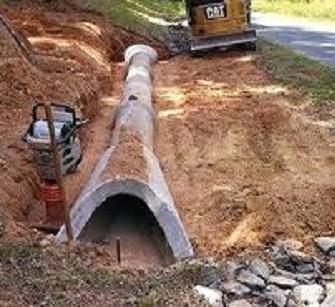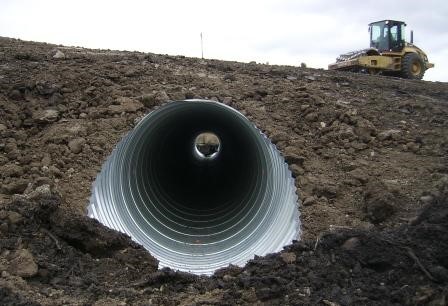Trustworthy Pad Construction for Your Project Demands
Trustworthy Pad Construction for Your Project Demands
Blog Article
Culvert Setup Facilitated: Step-by-Step Overview for Success
From picking the ideal culvert dimension to integrating appropriate drainage procedures, each step in the installment process plays a critical role in the capability and long life of the culvert system. Stay tuned to discover the essential steps and considerations that can make culvert installation a seamless and effective venture.
Selecting the Right Culvert Size
Choosing the appropriate culvert size is crucial for guaranteeing reliable water flow and structural stability in culvert installation tasks - Pad Construction. The size of the culvert straight affects the circulation ability of water via the framework. A culvert that is as well tiny can cause flooding and overflow, while one that is as well huge might lead to lowered water speed, potentially creating debris accumulation and obstructions
To identify the right culvert dimension, factors such as the watershed location, top flow prices, and hydraulic efficiency demand to be thoroughly considered. Calculations based on these criteria help in selecting a dimension that can adequately handle the anticipated water quantity while lessening the danger of clogs and structural failure.
It is necessary to get in touch with engineering standards and criteria to make sure that the selected culvert dimension fulfills the task demands and local laws (Pad Construction). By choosing the appropriate culvert dimension, project managers can optimize water circulation, prevent prospective concerns, and improve the total efficiency and longevity of the culvert installment
Preparing the Setup Site
Effective culvert installment necessitates meticulous preparation of the installment website to guarantee optimal structural support and performance. Before beginning the installation process, it is important to clear the website of any type of particles, greenery, or blockages that can hinder the culvert's positioning. Making sure a level structure is vital for the correct alignment and security of the culvert. This may involve rating the website to produce a smooth, also surface area that can appropriately sustain the weight of the culvert and any expected loads. In addition, proper compaction of the dirt underneath the culvert is essential to avoid clearing up or shifting in time.
Furthermore, it is very important to take into consideration variables such as dirt make-up, groundwater degrees, and ecological effects when preparing the installation site. Performing a thorough website assessment can help determine any possible difficulties or threats that may impact the culvert's performance. By taking the time to prepare the setup website properly, you can assist ensure a successful culvert installation that fulfills architectural requirements and ensures long-term capability.
Placing the Culvert Properly

The grade at which the culvert is positioned is crucial for keeping an appropriate slope for water flow. A steady slope helps protect against merging and promotes efficient water drainage. Additionally, the culvert must be oriented appropriately to make sure that the inlet and outlet Bonuses remain in the proper areas. This positioning is necessary for the culvert to function successfully in taking care of water flow.
Backfilling and Compacting the Dirt
Appropriate backfilling and compaction of the dirt around the culvert is vital to ensure security and protect against potential concerns in the future. As soon as the culvert is properly placed, the next essential action is to backfill the area around it with ideal product. The backfill product should be complimentary from rocks, particles, and raw material to stay clear of damages to the culvert. It is suggested to make use of granular product such as sand or gravel for backfilling, as it provides excellent water drainage and compaction properties.
After positioning the backfill product, it is very important to small it in layers of consistent thickness. Utilizing a compactor or a mechanical meddle, portable the soil gently to avoid harming the culvert. Compaction assists in decreasing the opportunities of negotiation and makes sure consistent assistance around the culvert. It is vital to compact the soil equally on all sides of the culvert to preserve its architectural integrity.
Correct backfilling and compaction not only provide security to the culvert however likewise aid in avoiding soil disintegration and preserving the durability of the culvert system.
Making Certain Correct Water Drainage Integration
Integrating effective drainage remedies plays a crucial duty in the general capability and long life of culvert installments. Correct drainage assimilation is necessary for handling water flow, stopping disintegration, and guaranteeing the structural stability of the culvert system. To achieve this, it is vital to make a thorough drain strategy that considers factors such as the volume of water expected, the topography of the area, and the sort of soil present.

Additionally, integrating features like disintegration control actions, such as riprap or plants, can further enhance the performance of the drainage system. By meticulously intending get redirected here and executing these drain options, Discover More Here culvert installments can function effectively and withstand the test of time.
Final Thought
Finally, correct culvert setup is essential for maintaining reliable drainage systems. By picking the appropriate culvert size, preparing the installation website, putting the culvert correctly, backfilling and condensing the soil, and ensuring proper water drainage assimilation, success can be attained. Adhering to these actions will certainly aid guarantee the long life and effectiveness of the culvert, ultimately adding to the overall success of the water drainage system.
Report this page